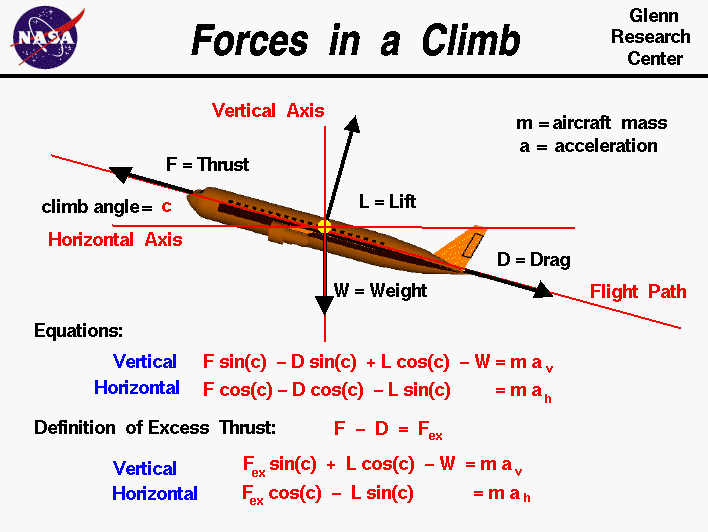
There are four forces that act on an
aircraft in flight:
lift,
weight,
thrust, and
drag.
The motion
of the aircraft through the air depends on the relative size of the
various forces and the orientation of the aircraft. For an aircraft
in cruise, the four forces are balanced,
and the aircraft moves at a constant velocity and altitude. On
this slide, we consider the relations of the forces during a gradual
climb. We have drawn a vertical and horizontal axis on our aircraft
through the center of gravity. The flight path
is shown as a red line inclined to the horizontal at angle c. The
lift and drag are aerodynamic forces that
are defined relative to the flight path. The lift is perpendicular to
the flight path and the drag is along the flight path. The thrust of
the aircraft is also usually aligned with the flight path. Some
modern fighter aircraft can
change the angle of the thrust,
but we
are going to assume that the thrust is along the flight path
direction. The weight of an airplane is always directed towards the
center of the earth and is, therefore, along the vertical axis.
Forces are
vector quantities.
We can write two
component
equations for the motion of the
aircraft based on Newton's second law of
motion and the rules of
vector algebra.
One equation gives the
the vertical acceleration av, and the other gives the
horiozontal acceleration ah in terms of the components
of the forces
and the mass m of the aircraft.
If we denote the thrust by the symbol F, the lift by L,
the drag by D, and the weight by W,
the vertical component equation is:
F * sin(c) - D * sin(c) + L * cos(c) - W = m * av
where sin and cos are the
trigonometric sine and cosine functions. Similarly,
the horizontal component equation is:
F * cos(c) - D * cos(c) - L * sin(c) = m * ah
We can simplify the
equations a little by using the definition of
excess thrust Fex:
Fex = F - D
The resulting equations of motion are:
Vertical: Fex * sin(c) + L * cos(c) - W = m * av
Horizontal: Fex * cos(c) - L * sin(c) = m * ah
For small climb angles, the cos(c) is nearly 1.0 and the sin(c) is
nearly zero.
The equations then reduce to:
Vertical: L - W = m * av
Horizontal: F - D = m * ah
The resulting simplified motion is described on another
slide. The horizontal equation is
integrated on another slide
to give the velocity and location as functions of time.
For more moderate angles, high
excess thrust can provide an important contribution to the vertical
acceleration. The next time you visit an airport, notice the high
climb angles used by modern airliners. This flight path is possible
because modern
turbine engines
develop high excess thrust at takeoff.
The pilot climbs sharply to get the aircraft as high as possible within
the confines of the airport which produces the
least noise for homes near the airport.
Activities:



Guided Tours
-
 Gradual Climb:
Gradual Climb:

Navigation ..

- Beginner's Guide Home Page
|
